Dickensians! discussion
Novellas and Collaborative Works
>
A Christmas Carol - Staves 1 - 2 (hosted by Connie and Sara)
message 151:
by
Robin P
(new)
Dec 04, 2020 07:50PM
 Ironic that being happy and generous seem to be signs of illness, while being serious and stingy are just normal.
Ironic that being happy and generous seem to be signs of illness, while being serious and stingy are just normal.
reply
|
flag
 Both links were quite interesting. How true that in the modern era we would have Scrooge analyzed and find him psychotic instead of accepting that a spiritual epiphany has been reached.
Both links were quite interesting. How true that in the modern era we would have Scrooge analyzed and find him psychotic instead of accepting that a spiritual epiphany has been reached.
 I agree with you Sara. Being that I live in a magical abundant universe, I agree, seeing how much more lonely this assessment makes Scrooge.
I agree with you Sara. Being that I live in a magical abundant universe, I agree, seeing how much more lonely this assessment makes Scrooge. I chose this article of the several I saw because it shows how Scrooge sees himself and how others might see him--both.
 John Leech was the first illustrator of A Christmas Carol. He was best known for his work for the humorous and satirical magazine "Punch," and his cartoons on the Crimean War. The Victorian Web has a page of his illustrations for A Christmas Carol with the second illustration showing Scrooge and the Ghost of Marley:
John Leech was the first illustrator of A Christmas Carol. He was best known for his work for the humorous and satirical magazine "Punch," and his cartoons on the Crimean War. The Victorian Web has a page of his illustrations for A Christmas Carol with the second illustration showing Scrooge and the Ghost of Marley:http://www.victorianweb.org/art/illus...
 Piyangie, I agree. The most surprising thing I learned was about using Thomas Malthus thoughts on the economy and population. I do not know how I missed that connection before.
Piyangie, I agree. The most surprising thing I learned was about using Thomas Malthus thoughts on the economy and population. I do not know how I missed that connection before.
 Connie wrote: "Laura, that's an interesting link with people's ideas about when the ghosts appeared. The comments below the article show that everyone has a slightly different explanation which makes it fun!"
Connie wrote: "Laura, that's an interesting link with people's ideas about when the ghosts appeared. The comments below the article show that everyone has a slightly different explanation which makes it fun!"I know! I love that everyone can bring their own interpretation and ideas - makes the reading so much richer!
 Laura wrote: "Robin my version alludes to the time issue in the introduction.
Laura wrote: "Robin my version alludes to the time issue in the introduction....when Scrooge, regenerated, finds that the Spirits have, as he had requested, completed their tasks in one night, not three..."
..."
Laura, I like the different ideas about the time issue in this link. An idea occurs to me...maybe Dickens just made a mistake? Maybe, he planned on taking the story in a different direction, changed his mind, and forgot to change this part.
 Oh, Debra, Sacrilege! LOL. With his love of the magical and the fact that these are spirits and not bound by our time restraints, I think it is just as he intended. After all faith is taking as fact something that cannot be proved.
Oh, Debra, Sacrilege! LOL. With his love of the magical and the fact that these are spirits and not bound by our time restraints, I think it is just as he intended. After all faith is taking as fact something that cannot be proved.
 Debra, it makes the book more magical that the spirits didn't work in our sense of time. The Ghosts of Past, Present, and the Future also took Scrooge through many years and great distances in the short time they were each allotted which is also magical. It's also perfect that Scrooge redeems himself on Christmas Day.
Debra, it makes the book more magical that the spirits didn't work in our sense of time. The Ghosts of Past, Present, and the Future also took Scrooge through many years and great distances in the short time they were each allotted which is also magical. It's also perfect that Scrooge redeems himself on Christmas Day.Near the end of Stave One, Scrooge asks, "Couldn't I take 'em all at once, and have it over, Jacob?" Maybe that's why all three Ghosts visited on the same night, granting his request.
 Cynda wrote: "I volunteer at the local YWCA where we remember and remind each other that the largest population we serve locally is the Elderly and Lonely--almost in capital letters we talk. Returning to Christm..."
Cynda wrote: "I volunteer at the local YWCA where we remember and remind each other that the largest population we serve locally is the Elderly and Lonely--almost in capital letters we talk. Returning to Christm..."What an interesting article! I enjoyed it and learned things about myself too (that personality disorder are more susceptible to have a short psychotic episode which no doctors took the time to explain) which I did not expect.
There's another perspective on the time issues, but since we haven't yet met any of the Spirits - or even know if they will visit as Jacob Marley has told Ebenezer Scrooge - I'll leave it until the right time :)
So far I think Ebenezer is merely a cantankerous man - a "good man of business" as he called his old partner Marley. He's not lazy - he works hard. As well as Thomas Malthus, he behaves well according to the economic theory of Adam Smith and Jeremy Bentham. After all, if poor people had a good time in workhouses (so the argument went) then they would be less inclined to work. Keep them cold, give them as little food as possible, any windows should be high up so you could see out of them etc.
His arguments make economic sense, and he is rich whereas his soft-hearted nephew is poor. He seems perfectly sane - even to suspecting Marley of being a bit of underdone beef. "You may be an undigested bit of beef, a blot of mustard, a crumb of cheese, a fragment of an underdone potato. There’s more of gravy than of grave about you, whatever you are!”
He cracked a joke, because he was trying to "keep down his terror". We were told there is nothing at all fanciful or airy-fairy about Scrooge: "Scrooge had as little of what is called fancy about him as any man in the city of London". Scrooge does not appear to have any mental problems, he is sane and logical - and has feelings. We just don't like him very much!
So far I think Ebenezer is merely a cantankerous man - a "good man of business" as he called his old partner Marley. He's not lazy - he works hard. As well as Thomas Malthus, he behaves well according to the economic theory of Adam Smith and Jeremy Bentham. After all, if poor people had a good time in workhouses (so the argument went) then they would be less inclined to work. Keep them cold, give them as little food as possible, any windows should be high up so you could see out of them etc.
His arguments make economic sense, and he is rich whereas his soft-hearted nephew is poor. He seems perfectly sane - even to suspecting Marley of being a bit of underdone beef. "You may be an undigested bit of beef, a blot of mustard, a crumb of cheese, a fragment of an underdone potato. There’s more of gravy than of grave about you, whatever you are!”
He cracked a joke, because he was trying to "keep down his terror". We were told there is nothing at all fanciful or airy-fairy about Scrooge: "Scrooge had as little of what is called fancy about him as any man in the city of London". Scrooge does not appear to have any mental problems, he is sane and logical - and has feelings. We just don't like him very much!
My favourite quotations from this First Stave, apart from the ones Debra mentioned are:
“Darkness was cheap, and Scrooge liked it.”
“Bah!” said Scrooge, “Humbug!”
“He lived in chambers that had once belonged to his deceased partner. They were a gloomy suite of rooms, in a lowering pile of building up a yard, where it had so little business to be, that one could scarcely help fancying it must have run there when it was a young house, playing at hide-and-seek with other houses, and forgotten the way out again.”
The ancient tower of a church, whose gruff old bell was always peeping slily down at Scrooge out of a Gothic window in the wall, became invisible, and struck the hours and quarters in the clouds, with tremulous vibrations afterwards as if its teeth were chattering in its frozen head up there. The cold became intense.
I feel these second two could not have been written by anyone except Charles Dickens. Houses, furniture clocks - all have their own distinct personalities in his books :)
“Darkness was cheap, and Scrooge liked it.”
“Bah!” said Scrooge, “Humbug!”
“He lived in chambers that had once belonged to his deceased partner. They were a gloomy suite of rooms, in a lowering pile of building up a yard, where it had so little business to be, that one could scarcely help fancying it must have run there when it was a young house, playing at hide-and-seek with other houses, and forgotten the way out again.”
The ancient tower of a church, whose gruff old bell was always peeping slily down at Scrooge out of a Gothic window in the wall, became invisible, and struck the hours and quarters in the clouds, with tremulous vibrations afterwards as if its teeth were chattering in its frozen head up there. The cold became intense.
I feel these second two could not have been written by anyone except Charles Dickens. Houses, furniture clocks - all have their own distinct personalities in his books :)
Here are two images from this First Stave. The first is the one Connie mentioned, from the original by John Leech:

Marley's Ghost visits Scrooge - John Leech
This second is by a later English illustrator from the "golden age", who specialised in illustrating classics, folk tales and children's stories: Arthur Rackham. I like this one very much :)
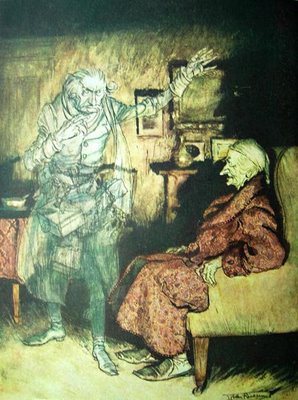
Marley Ghost visits Ebenezer Scrooge - Arthur Rackham
We have just one more day on this Stave :)

Marley's Ghost visits Scrooge - John Leech
This second is by a later English illustrator from the "golden age", who specialised in illustrating classics, folk tales and children's stories: Arthur Rackham. I like this one very much :)

Marley Ghost visits Ebenezer Scrooge - Arthur Rackham
We have just one more day on this Stave :)
 Bionic Jean wrote: "There's another perspective on the time issues, but since we haven't yet met any of the Spirits - or even know if they will visit as Jacob Marley has told Ebenezer Scrooge - I'll leave it until the..."
Bionic Jean wrote: "There's another perspective on the time issues, but since we haven't yet met any of the Spirits - or even know if they will visit as Jacob Marley has told Ebenezer Scrooge - I'll leave it until the..."I had not considered that, at this point, we do not really know that time is an issue. So, perhaps Dickens was just trying to fool us.
 The first time I saw Marley when I was a kid, I thought he had died with a toothache and I thought an eternal toothache was one of his punishment; I learned later that the band of cloth was to keep the mouth of deceased close.
The first time I saw Marley when I was a kid, I thought he had died with a toothache and I thought an eternal toothache was one of his punishment; I learned later that the band of cloth was to keep the mouth of deceased close.
 I finally got to my local used book store to pick up a copy of the book. I can't remember when I first read the story. Probably when I was in middle school. Anyway, even though I am just a few pages in, I realize I surely didn't appreciate the writing as I do now. How Dickens sets the atmosphere and thoroughly describes Scrooge's character is incredible.
I finally got to my local used book store to pick up a copy of the book. I can't remember when I first read the story. Probably when I was in middle school. Anyway, even though I am just a few pages in, I realize I surely didn't appreciate the writing as I do now. How Dickens sets the atmosphere and thoroughly describes Scrooge's character is incredible.I have certainly enjoyed all the commentary and the moderators' background information. Thanks!
 Jean, those are wonderful quotations you shared! Thank you for posting the illustrations. The Rackham illustration is in the version that I'm reading, and shows the chains, and the assorted money boxes that Marley has to drag around very well.
Jean, those are wonderful quotations you shared! Thank you for posting the illustrations. The Rackham illustration is in the version that I'm reading, and shows the chains, and the assorted money boxes that Marley has to drag around very well.
 Chris, it's great that you found a copy of the book and are joining us. I've read Stave One numerous times in the past couple weeks and am still finding quotations that I love. While Dickens had been thinking about the book for longer, it's a marvel that he could write this so masterfully in six weeks! We probably read for the plot when we were kids, but now appreciate the beautiful writing.
Chris, it's great that you found a copy of the book and are joining us. I've read Stave One numerous times in the past couple weeks and am still finding quotations that I love. While Dickens had been thinking about the book for longer, it's a marvel that he could write this so masterfully in six weeks! We probably read for the plot when we were kids, but now appreciate the beautiful writing.
 No number of re-reads ever makes this story stale for me, or the impact of its message fade. Truly my favorite tale of all.
No number of re-reads ever makes this story stale for me, or the impact of its message fade. Truly my favorite tale of all.
 Lauren wrote: "No number of re-reads ever makes this story stale for me, or the impact of its message fade. Truly my favorite tale of all."
Lauren wrote: "No number of re-reads ever makes this story stale for me, or the impact of its message fade. Truly my favorite tale of all.""A Christmas Carol" has never been out of print so it's truly a beloved book. Enjoy your reread, Lauren!
 Bionic Jean wrote: "My favourite quotations from this First Stave, apart from the ones Debra mentioned are:
Bionic Jean wrote: "My favourite quotations from this First Stave, apart from the ones Debra mentioned are:“Darkness was cheap, and Scrooge liked it.”
“Bah!” said Scrooge, “Humbug!”
“He lived in chambers that had ..."
Yes, I love the personification of the buildings, furniture, etc. and you are right that it is so Dickensian. We don't see this type of playfulness , while still imparting a real impression, in other Victorian authors that I can think of.
And France-Andrée, I didn't realize that about the jaw being tied up on dead people. I thought it was just another way to keep warm at night, like wearing a nightcap!
 I read this every single year without fail, it is the perfect book for this time of the year. When I was a language teacher, I bought simplified versions for my students to read, almost everyone loved the sentiments in this tale.
I read this every single year without fail, it is the perfect book for this time of the year. When I was a language teacher, I bought simplified versions for my students to read, almost everyone loved the sentiments in this tale.
 G.J. wrote: "I read this every single year without fail, it is the perfect book for this time of the year. When I was a language teacher, I bought simplified versions for my students to read, almost everyone lo..."
G.J. wrote: "I read this every single year without fail, it is the perfect book for this time of the year. When I was a language teacher, I bought simplified versions for my students to read, almost everyone lo..."How wonderful to introduce your students to "A Christmas Carol!" I noticed that there were versions in my library for various ages with many styles of illustrations. I hope you enjoy your reread this year. Please share your thoughts about the book as you're reading.
 Beyond the appeal of the story itself, much of the power of this short novel derives from its murky atmosphere and starkly drawn characters. It seems to me that it's a work that cries out for illustrations to echo and reinforce Dickens' s richly visual prose. Accordingly, from among the many fine editions available today, I chose the 2006 Candlewick Press edition with illustrations by P. J. Lynch, aiming thereby to gain a sense of what Dickens set out to accomplish with his beautiful original publication.
Beyond the appeal of the story itself, much of the power of this short novel derives from its murky atmosphere and starkly drawn characters. It seems to me that it's a work that cries out for illustrations to echo and reinforce Dickens' s richly visual prose. Accordingly, from among the many fine editions available today, I chose the 2006 Candlewick Press edition with illustrations by P. J. Lynch, aiming thereby to gain a sense of what Dickens set out to accomplish with his beautiful original publication.


This is the book with lovely watercolor illustrations that Jim is referring to in the comment above this. I hope you're enjoying your read!
 Thank you, Connie and Jean and Kathryn and everyone for such wonderful comments. I have been learning so much. I watched The Man Who Invented Christmas last evening and found it to be a fun addition to the Dickens oeuvres.
Thank you, Connie and Jean and Kathryn and everyone for such wonderful comments. I have been learning so much. I watched The Man Who Invented Christmas last evening and found it to be a fun addition to the Dickens oeuvres.
 Antoinette wrote: "Thank you, Connie and Jean and Kathryn and everyone for such wonderful comments. I have been learning so much. I watched The Man Who Invented Christmas last evening and found it to be a fun additio..."
Antoinette wrote: "Thank you, Connie and Jean and Kathryn and everyone for such wonderful comments. I have been learning so much. I watched The Man Who Invented Christmas last evening and found it to be a fun additio..."Thanks for the recommendation, Antoinette. I've been amazed at the number of movies of "A Christmas Carol", and about Dickens writing the book. There are over 6,000 editions of "A Christmas Carol" listed on Goodreads too.
It's great to have several members joining in this who weren't able to join our longer reads. And as Chris, Robin and others have said, I think we're all noticing how extremely well written this is - especially if our memories are from retellings long ago as children, or various films. A Christmas Carol is one of those books where the story is so well known, through constant retellings, that we forget how delightful it is to read the original text :)
Connie has given us some great background material to the tale, and we've mentioned how unique Charles Dickens is, in personifying not only animals. but also humdrum houses, or even articles of furniture. He employs the pathetic fallacy in this way, more than any other author I know, and it gives his writing a modern, lively feel. I mentioned before how cosy and chatty it seems to me :)
Another aspect which comes through to me very strongly in the first stave is how many discordant sounds there are. Take the quotation we enjoyed earlier:
“Oh! but he was a right-fisted hand at the grindstone, Scrooge! a squeezing, wrenching, grasping, scraping, clutching, covetous old sinner! Hard and sharp as flint, from which no steel had ever struck out generous fire”
If we look at this we can see Charles Dickens often uses words which sound a bit like the sound they describe ("onomatopoeia") and with “secret, and self-contained, and solitary as an oyster.” he is using alliteration, for a similar effect.
Always Charles Dickens stresses the feelings we have: the night with its “piercing, searching, biting cold”. And he will repeat a word for effect: Scrooge has a “melancholy dinner in his usual melancholy tavern” before going back to his “dreary” home. And when Marley’s ghost appears, we have a “booming sound". We have "clanking of chains", and “the air was filled with phantoms ... moaning as they went”.
To say we have a solitary figure, in a dark and foggy winter evening, we have a lot of sounds! But none of them are pleasant.
Already I think this story has a very gothic feel. We have elements of the supernatural, the grotesque, the theme of flight and pursuit - and the presence of terror. Also, Gothic novels are frequently framed by multiple sources of story telling (e.g. letters, multiple narrators, and flashbacks) which all combine to weave the plot together. Since we have been told that Scrooge is to be visited by 3 spirits in turn, this also seems quite likely.
If I don't get chance before Stave 2 tomorrow, Connie, thank you so much for all the work you have put in on this. It's been fascinating!
Connie has given us some great background material to the tale, and we've mentioned how unique Charles Dickens is, in personifying not only animals. but also humdrum houses, or even articles of furniture. He employs the pathetic fallacy in this way, more than any other author I know, and it gives his writing a modern, lively feel. I mentioned before how cosy and chatty it seems to me :)
Another aspect which comes through to me very strongly in the first stave is how many discordant sounds there are. Take the quotation we enjoyed earlier:
“Oh! but he was a right-fisted hand at the grindstone, Scrooge! a squeezing, wrenching, grasping, scraping, clutching, covetous old sinner! Hard and sharp as flint, from which no steel had ever struck out generous fire”
If we look at this we can see Charles Dickens often uses words which sound a bit like the sound they describe ("onomatopoeia") and with “secret, and self-contained, and solitary as an oyster.” he is using alliteration, for a similar effect.
Always Charles Dickens stresses the feelings we have: the night with its “piercing, searching, biting cold”. And he will repeat a word for effect: Scrooge has a “melancholy dinner in his usual melancholy tavern” before going back to his “dreary” home. And when Marley’s ghost appears, we have a “booming sound". We have "clanking of chains", and “the air was filled with phantoms ... moaning as they went”.
To say we have a solitary figure, in a dark and foggy winter evening, we have a lot of sounds! But none of them are pleasant.
Already I think this story has a very gothic feel. We have elements of the supernatural, the grotesque, the theme of flight and pursuit - and the presence of terror. Also, Gothic novels are frequently framed by multiple sources of story telling (e.g. letters, multiple narrators, and flashbacks) which all combine to weave the plot together. Since we have been told that Scrooge is to be visited by 3 spirits in turn, this also seems quite likely.
If I don't get chance before Stave 2 tomorrow, Connie, thank you so much for all the work you have put in on this. It's been fascinating!
Some more quotations, humorous and grotesque by turn:
“Marley was dead, to begin with. There was no doubt whatever about that.”
What a great way to start a supernatural story: with an eminently practical comment!
I got the chills with this one, by Marley's ghost:
"I wear the chain I forged in life. I made it link by link, and yard by yard; I girded it on my own free will, and on my own free will I wore it. Is its pattern strange to you?"
The humour is often allied with the grotesque:
"The Ghost, on hearing this, set up another cry, and clanked its chain so hideously in the dead silence of the night, that the Ward would have been justified in indicting it for a nuisance."
But usually the humour wins out :)
"Wherefore the clerk put on his white comforter, and tried to warm himself at the candle; in which effort, not being a man of strong imagination, he failed."
Yes, a comforter is a nice thick scarf to snuggle down into :) And the humour does not let up:
"Scrooge had often heard it said that Marley had no bowels, but he had never believed it until now."
How about the hot vapours that Scrooge sees stirring Marley's hair, or the colour of "a bad lobster in a dark cellar" - or the absurdly comical moment when, despite his scepticism, Scrooge peers behind the door, half afraid to see Marley's pigtail on the other side!
“Marley was dead, to begin with. There was no doubt whatever about that.”
What a great way to start a supernatural story: with an eminently practical comment!
I got the chills with this one, by Marley's ghost:
"I wear the chain I forged in life. I made it link by link, and yard by yard; I girded it on my own free will, and on my own free will I wore it. Is its pattern strange to you?"
The humour is often allied with the grotesque:
"The Ghost, on hearing this, set up another cry, and clanked its chain so hideously in the dead silence of the night, that the Ward would have been justified in indicting it for a nuisance."
But usually the humour wins out :)
"Wherefore the clerk put on his white comforter, and tried to warm himself at the candle; in which effort, not being a man of strong imagination, he failed."
Yes, a comforter is a nice thick scarf to snuggle down into :) And the humour does not let up:
"Scrooge had often heard it said that Marley had no bowels, but he had never believed it until now."
How about the hot vapours that Scrooge sees stirring Marley's hair, or the colour of "a bad lobster in a dark cellar" - or the absurdly comical moment when, despite his scepticism, Scrooge peers behind the door, half afraid to see Marley's pigtail on the other side!
There just so many illustrations to A Christmas Carol. Even not counting more recent ones, and sticking to within 60 or so years of publication there are dozens for each Stave. I'll share just a few more of my favourites for this first section, and please do remember that Connie has given us a link to those by the original illustrator John Leech (whom we learned Charles Dickens later mesmerised!)
Here is Bob Cratchit in his little cell:
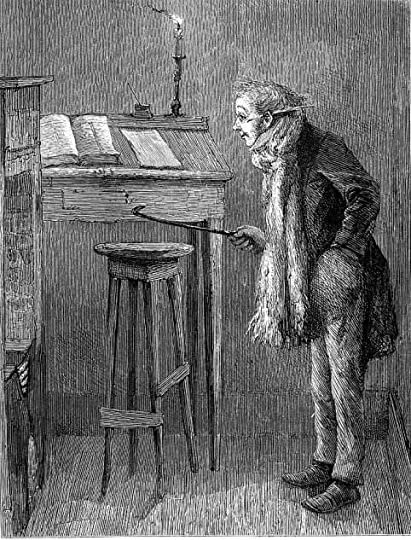
'In the Tank' - Sol Eytinge 1869
Here is where Scrooge complains that Bob Cratchit is picking his pocket every year, by wanting a day off:
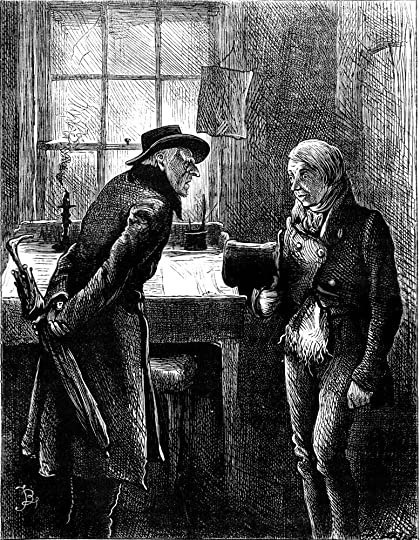
Scrooge reprimands Bob Cratchit, before he leaves for home - Fred Barnard 1878
This is when Scrooge arrives home, and has his first clue of what is to come. Several artists have drawn the knocker larger than life, but I like this one the very best. It seems so huge, and to convey Scrooge's sensations so well:

'The Ghostly Knocker' - Harry Furniss 1910
It's no good trying to get any money out of Ebenezer Scrooge:
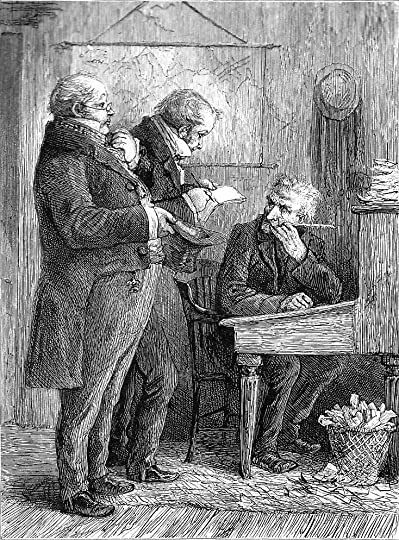
'The Philanthropists' - Sol Eytinge 1869
Here is Bob Cratchit in his little cell:

'In the Tank' - Sol Eytinge 1869
Here is where Scrooge complains that Bob Cratchit is picking his pocket every year, by wanting a day off:

Scrooge reprimands Bob Cratchit, before he leaves for home - Fred Barnard 1878
This is when Scrooge arrives home, and has his first clue of what is to come. Several artists have drawn the knocker larger than life, but I like this one the very best. It seems so huge, and to convey Scrooge's sensations so well:

'The Ghostly Knocker' - Harry Furniss 1910
It's no good trying to get any money out of Ebenezer Scrooge:

'The Philanthropists' - Sol Eytinge 1869
The Ghost of Jacob Marley appears:
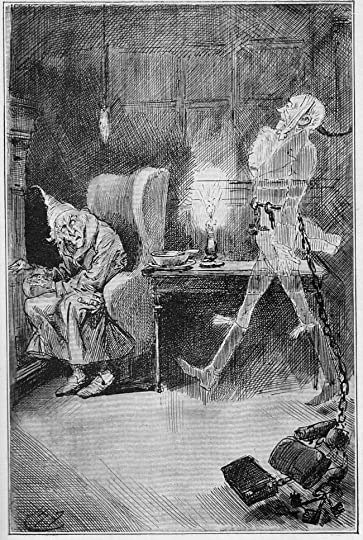
Scrooge and Marley's Ghost - Harry Furniss - 1910
And this one shows how terrified Scrooge is, to see his former partner, who had been dead for 7 years:
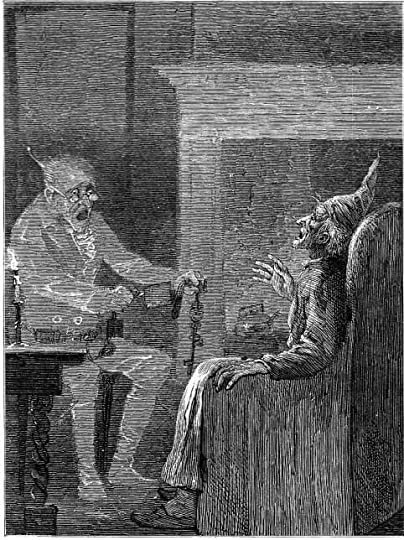
Marley's Ghost - Sol Eytinge 1869
Here are the phantoms, watched by Scrooge through his window:
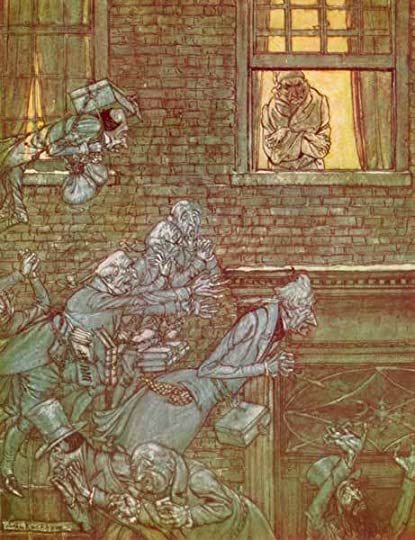
Distressed Spirits - Arthur Rackham
And here are more phantoms, wailing piteously, as they are now unable to help those in need:
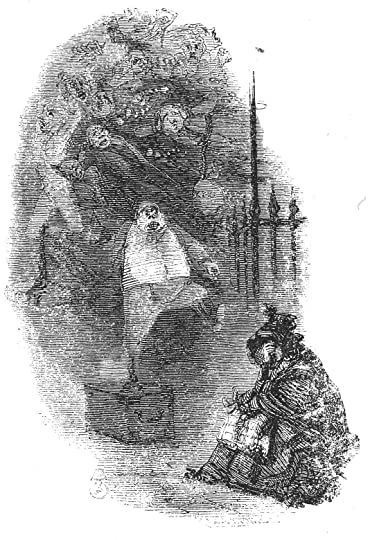
Phantoms wailing as they watch the destitute - John Leech 1843
And they finally drift away:
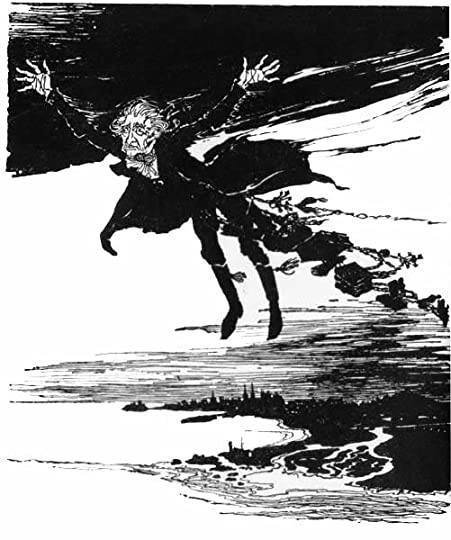
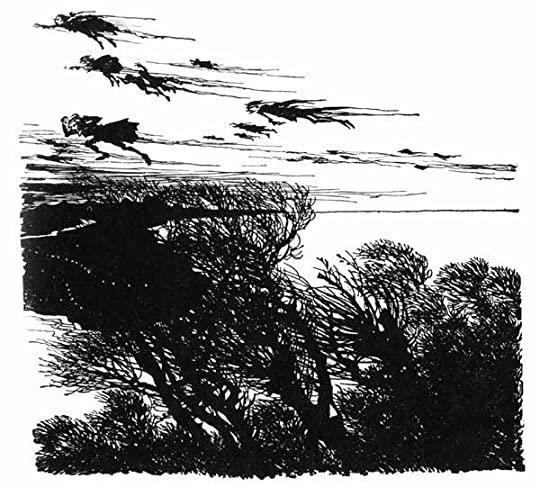
'On the Wings of the Wind' - Arthur Rackham 1910

Scrooge and Marley's Ghost - Harry Furniss - 1910
And this one shows how terrified Scrooge is, to see his former partner, who had been dead for 7 years:

Marley's Ghost - Sol Eytinge 1869
Here are the phantoms, watched by Scrooge through his window:

Distressed Spirits - Arthur Rackham
And here are more phantoms, wailing piteously, as they are now unable to help those in need:

Phantoms wailing as they watch the destitute - John Leech 1843
And they finally drift away:


'On the Wings of the Wind' - Arthur Rackham 1910
 Bionic Jean wrote: "personifying not only animals. but also humdrum houses, or even articles of furniture. He employs the pathetic fallacy in this way, more than any other author I know ..."
Bionic Jean wrote: "personifying not only animals. but also humdrum houses, or even articles of furniture. He employs the pathetic fallacy in this way, more than any other author I know ..."Thank you Jean for highlighting this aspect of Dickens. I have found that pathetic fallacy can be extremely effective — as opposed to anthropomorphism, which rarely works for me at all!
 Another sound that is quite scary is all the bells that announce the arrival of Marley’s Ghost. In my audio, they put actual bells and you do feel like they go on even though it’s brief. This is the passage:
Another sound that is quite scary is all the bells that announce the arrival of Marley’s Ghost. In my audio, they put actual bells and you do feel like they go on even though it’s brief. This is the passage: “As he threw his head back in the chair, his glance happened to rest upon a bell, a disused bell, that hung in the room, and communicated for some purpose now forgotten with a chamber in the highest story of the building. It was with great astonishment, and with a strange, inexplicable dread, that as he looked, he saw this bell begin to swing. It swung so softly in the outset that it scarcely made a sound; but soon it rang out loudly, and so did every bell in the house.
This might have lasted half a minute, or a minute, but it seemed an hour. The bells ceased as they had begun, together.”
Thank you Connie for your insights.
 Thank you for your fascinating information, Jean. I love seeing how different illustrators interpret A Christmas Carol.
Thank you for your fascinating information, Jean. I love seeing how different illustrators interpret A Christmas Carol.
 France-Andree, it would give me chills listening to the bells before the entrance of the ghosts. It could be an ominous sound especially with base tones. Thanks for sharing the quotation too.
France-Andree, it would give me chills listening to the bells before the entrance of the ghosts. It could be an ominous sound especially with base tones. Thanks for sharing the quotation too.
 Love the illustrations, particularly "On the Wings of the Wind" which has a surreal feeling to it. Have truly enjoyed all the insights and thoughts from everyone.
Love the illustrations, particularly "On the Wings of the Wind" which has a surreal feeling to it. Have truly enjoyed all the insights and thoughts from everyone. The story is so familiar from a lifetime of reading, watching or hearing it, but then there are the surprises that come when you read a particular description or realize that something is portrayed quite differently in the book than you remember from your favorite film version. I wondered if I would be able to get in a Christmassy mood this year, but reading this has me humming Christmas Carols.
Yes, the bells! Yet another example: clanking and cacophonous! Thanks France-Andrée.
Jim - Oddly enough, I was in the middle of searching out some of the best illustrations when you must have posted! The edition with illustrations by P. J. Lynch which you have selected, is one of the modern ones I already have on my wish list :) They look superb.
Another I have is the Pears Centenary Edition from 1912. (Will add the link later - it isn't working!) These were issued each year, to commemorate one of the five Christmas books. This one was illustrated in monochrome water colours, with a photographic feel, by Charles Green.
I do know what you mean by finding the pathetic fallacy more effective than anthropomorphising. Perhaps it is because it is not overused? I like children's books very much, and they tend to anthropomorphise a lot! Some are excellent, but it has to be said that there are far too many twee, badly written ones too.
Jim - Oddly enough, I was in the middle of searching out some of the best illustrations when you must have posted! The edition with illustrations by P. J. Lynch which you have selected, is one of the modern ones I already have on my wish list :) They look superb.
Another I have is the Pears Centenary Edition from 1912. (Will add the link later - it isn't working!) These were issued each year, to commemorate one of the five Christmas books. This one was illustrated in monochrome water colours, with a photographic feel, by Charles Green.
I do know what you mean by finding the pathetic fallacy more effective than anthropomorphising. Perhaps it is because it is not overused? I like children's books very much, and they tend to anthropomorphise a lot! Some are excellent, but it has to be said that there are far too many twee, badly written ones too.
 Sara wrote: "Love the illustrations, particularly "On the Wings of the Wind" which has a surreal feeling to it. Have truly enjoyed all the insights and thoughts from everyone.
Sara wrote: "Love the illustrations, particularly "On the Wings of the Wind" which has a surreal feeling to it. Have truly enjoyed all the insights and thoughts from everyone. The story is so familiar from a ..."
I have found reading "A Christmas Carol" uplifting too. We hear so much sad news during this pandemic that it's good to escape to another world reading a book with such a heartwarming message.
 Yes, Connie, and to realize that no matter how difficult the times might be, you do not want to end up having Scrooge's attitude before the intercession.
Yes, Connie, and to realize that no matter how difficult the times might be, you do not want to end up having Scrooge's attitude before the intercession.
 This is still my favorite book of all time. I'm doing a free live reading of it on Zoom / Facebook live over 3 sessions starting this Tuesday, December 8th at 7 PM ET. You can join the call here:
This is still my favorite book of all time. I'm doing a free live reading of it on Zoom / Facebook live over 3 sessions starting this Tuesday, December 8th at 7 PM ET. You can join the call here:https://us02web.zoom.us/j/85705253987
Fore more info click here
https://www.bennyfifeaudio.com/a-chri...
 Jumping in on the last day of Stave 1 and am enjoying catching up on all of the comments and input provided. I am like most who have memories of the movie versions from long ago. I’ve finished reading the first section and don’t think I’ve ever read the original. So glad that I can remedy that now and enjoy all the knowledge of everyone here in the group.
Jumping in on the last day of Stave 1 and am enjoying catching up on all of the comments and input provided. I am like most who have memories of the movie versions from long ago. I’ve finished reading the first section and don’t think I’ve ever read the original. So glad that I can remedy that now and enjoy all the knowledge of everyone here in the group. Connie, I’ve enjoyed everything you’ve presented and know that you’ve put in so much valuable time in doing so. Thank you for your time and effort!
I have especially enjoyed being able to put Dickens’ words to the images that I’m so familiar with. I think the written descriptions and moods of the visuals such as Marley’s chains and such are so effectively written.
 Lori wrote: "Jumping in on the last day of Stave 1 and am enjoying catching up on all of the comments and input provided. I am like most who have memories of the movie versions from long ago. I’ve finished read..."
Lori wrote: "Jumping in on the last day of Stave 1 and am enjoying catching up on all of the comments and input provided. I am like most who have memories of the movie versions from long ago. I’ve finished read..."Having read it at least 20 times, When I watch the movie versions, there are some that I think capture one part so well, and others on different ones. Patrick Stewart & TNT's version has Scrooge sometimes voicing the lines of the narration & I loved that. Stave 1 in that version actually starts at Marley's funeral & as he's signing the mourners book he comments about Marley being dead as a doornail and so forth. :)
 The first year my wife & I were married (2000) I bought a (used) 3 piece suit, spraypainted it white, got a towchain & a rag to wrap around my head & was Jacob Marley for Halloween. This year, I started growing a moustache in April, and the rest of the beard in September & now I look a bit like Dickens himself. I even got a tophat.
The first year my wife & I were married (2000) I bought a (used) 3 piece suit, spraypainted it white, got a towchain & a rag to wrap around my head & was Jacob Marley for Halloween. This year, I started growing a moustache in April, and the rest of the beard in September & now I look a bit like Dickens himself. I even got a tophat.
 Benjamin wrote: "This is still my favorite book of all time. I'm doing a free live reading of it on Zoom / Facebook live over 3 sessions starting this Tuesday, December 8th at 7 PM ET. You can join the call here:
Benjamin wrote: "This is still my favorite book of all time. I'm doing a free live reading of it on Zoom / Facebook live over 3 sessions starting this Tuesday, December 8th at 7 PM ET. You can join the call here:h..."
Thanks for the information, Benjamin.
 Lori wrote: "Jumping in on the last day of Stave 1 and am enjoying catching up on all of the comments and input provided. I am like most who have memories of the movie versions from long ago. I’ve finished read..."
Lori wrote: "Jumping in on the last day of Stave 1 and am enjoying catching up on all of the comments and input provided. I am like most who have memories of the movie versions from long ago. I’ve finished read..."It is a treat to read Dickens' original words. It's good to have you reading with us. Let us know if you have a favorite movie version.
Books mentioned in this topic
David Copperfield (other topics)Winnie-the-Pooh (other topics)
Charles Dickens Magician: Conjuring in Life, Letters and Literature (other topics)
A Christmas Carol (other topics)
Tales of a Thousand and One Nights: Volume 1 (other topics)
More...
Authors mentioned in this topic
Arthur Rackham (other topics)Charles Dickens (other topics)
Globe Fearon (other topics)
Charles Dickens (other topics)
Charles Dickens (other topics)
More...





